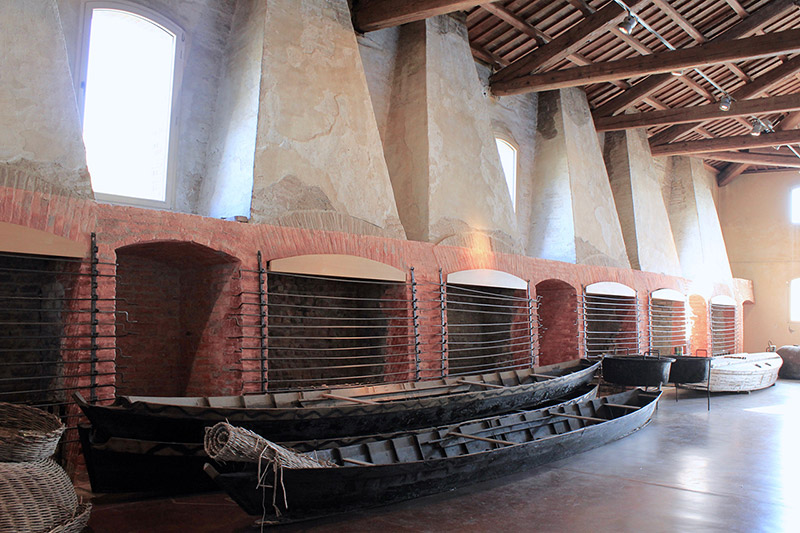








The eel of the Comacchio Valleys
Echoes of the fabulous banquets of the Este family tantalize foodies passing through the Ferrara area

Where

The eel is a ubiquitous fish, but there is one place in Italy, The Comacchio Valleys, where its farming and processing have unparalleled modalities. Comacchio is a "little Venice" of the early Ferrarese hinterland: an historic center, so to speak 'amphibious,' on 12 small islands, and a crown of brackish lagoons, the so-called 'valleys,' where fine fish have been bred according to their natural cycles since ancient times. Eel in primis, which represents the city's true gastronomic pride: "spit-roasted, fried, roasted, stewed, it is widely consumed especially at Christmas Eve lunches," reads the first Italian Touring Club Gastronomic Guide. To listen to the best informed, today there are 48 recipes for it, starting with a risotto in which there is a hint of nutmeg. The primacy of popularity, however, goes to the marinated eel, which still carries the name of Comacchio around Italy and the world; a delicacy for true connoisseurs, considering the intensity (and also the price).
A special fish
The eel is itself a special fish, which scientifically is defined as a catadromous migrant: it is born at sea, in the Atlantic depths of the Sargasso Sea, and completes the first stages of development during its journey to continental lands, then ascends its rivers, where it lives to maturity (10-15 years), and finally takes the reverse route to reproduce. Into this cycle comes man, with fishing and farming. Marinated eel is then a real specialty. Cooked over an open wood fire and then canned under brine of a particular composition: water, white wine vinegar and Cervia sea salt, plus a bay leaf, in the proportions dictated by an 1818 specification, now under the auspices of a Slow Food Presidium. Fishing and production take place in late autumn, which is why we are talking about a fish and preserve that have their moment of glory around Christmas, a circumstance that makes them even more special.
Manifattura dei Marinati
The place that brings together the history and actuality of the Comacchio eel is the so-called Manifattura dei Marinati, the old canning factory that has recently found new reality by combining the production function with the museum function. The heart of the factory is the Sala dei Fuochi (Hall of Fires), which sees lined up the twelve large fireplaces where eels are still spit-roasted over wood fires, as required by the production specification for the traditional marinated eel of the Comacchio Valleys. The Sala dei Fuochi is connected on one side with the Calata or Fossa, where boats full of eels used to land, and on the other with the Sala degli Aceti, with the large vats and barrels for brine. In the autumn period, it is possible to witness the entire processing cycle of eels but also of other fish, anchovies and aquadelle, destined for marinating. Tastings are held in this same environment.
 Comacchio, Manifattura dei Marinati: the hall with the large fireplaces for spit-roasting eels
Comacchio, Manifattura dei Marinati: the hall with the large fireplaces for spit-roasting eelsA centuries-long love affair
Despite its less-than-inviting appearance, the eel is highly prized for its exceptionally tasty, though rather fatty, meat, but precisely for this reason among the most suitable for skewering and grilling. The ancient Romans, who already knew the secrets of its breeding, were fond of it and accompanied it with elaborate sauces. On the strength of such consideration, it can be said that the eel passed unscathed even through the dark ages, landing with increasingly complex recipes on medieval and Renaissance tables. It is no coincidence, then, that the 16th-century cook Bartolomeo Scappi, who made his name at the doge's court in Venice, refers to Comacchio itself, "la qual'è circondata di valli d'acqua salsa," and about its eels he adds that not only "se pigliane gran quantità" but also that "son le migliori di qualunque loco." Emphasizing how, "roasted on the spit with his tart," they were worthy of a princely banquet. Today more complex preparations, such as pies and timballi, are obsolete, but the eel's fortunes continue in simpler recipes, often derived from regional cuisines.
Pairings
Faced with a food of such importance the question arises as to its pairing with a wine. A seemingly universal principle dictates that fish should be served with white wine, but eel is precisely one of those cases where the proverb "nulla regula sine exceptione." finds application. In fact, eel should more properly be paired with a young red wine, possibly slightly tannic, that is, with an astringent taste, to balance the fattiness of the fish. And without going too far, just tap into the production of the Ferrarese, the historic Bosco Eliceo wines, among which Fortana stands out, said to have been imported in the 16th century from Burgundy. A wine naturally inclined to fizz, which is precisely why it is said to be suitable for eel. As for marinated fish, in theory the acidic brine should put any pairing out of the running, but it does not seem that the Comacchio people give it a second thought, for there are also those who - à la guerre comme à la guerre - recommend a Champagne.
Enter the Map of Italy's Undiscovered Wonders and find treasures where you least expect it... Inspire, Recommend, Share...
The Map thanks:
In the Community
Enter the Map of Italy's Undiscovered Wonders and find treasures where you least expect it... Inspire, Recommend, Share...
Where


